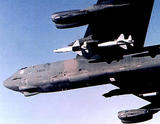AP AND AFP, WASHINGTON
Friday, Sep 07, 2007, Page 7
A US Air Force B-52 bomber flew for more than three hours across several states while carrying six cruise missiles under its wings mistakenly armed with nuclear warheads, Pentagon officials say.
The incident last Thursday triggered an Air Force probe and the firing of a commander, Pentagon officials said on Wednesday.
US President George W. Bush and Secretary of Defense Robert Gates were informed immediately after the mistake came to light, and Gates has asked for daily briefings on the Air Force inquiry, Defense Department press secretary Geoff Morrell said.
The B-52 originated at Minot Air Base in North Dakota and flew to Barksdale Air Force Base in Louisiana, said air force officials, who spoke on condition of anonymity because of a Pentagon policy not to confirm information on nuclear weapons.
The US Air Force has relieved the munition squadron commander at Minot of his duties, and launched an investigation into last Thursday's incident, a Pentagon spokesman said.
"At no time was there a threat to public safety," Lieutenant Colonel Ed Thomas said.
"It is important to note that munitions were safe, secure and under military control at all times," he said.
The Pentagon would not provide details, citing secrecy rules, but an expert said the incident was unprecedented, and pointed to a disturbing lapse in the air force's command and control system.
"It seems so fantastic that so many points, checks can dysfunction," said Hans Kristensen, an expert on US nuclear forces.
"We have so many points and checks specifically so we don't have these kinds of incidents," he said.
"That's perhaps what is most worrisome about this particular incident -- that apparently an individual who had command authority about moving these weapons around decided to do so," he said.
"It's a command and control issue and it's one that calls into question the system, because if one individual can do that who knows what can happen," he said.
Nuclear weapons are normally transferred on cargo planes, never on the wings of bombers, he said.
Bomber flights with live nuclear weapons ended in the late 1960s after accidents in Spain in 1966 and in Greenland in 1968.
US lawmakers expressed outrage at the incident.
Representative Ike Skelton, Democratic chairman of the Armed Services Committee in the House of Representatives, called the mishandling of the weapons "deeply disturbing" and said the committee would press the military for details.
"It is absolutely inexcusable that the Air Force lost track of these five nuclear warheads, even for a short period of time," Representative Edward Markey, a Democrat on the House Homeland Security Committee, said in a statement.
"Nothing like this has ever been reported before and we have been assured for decades that it was impossible," Markey said.
The breach originally was reported by the Military Times newspaper on Wednesday and was later confirmed by the Pentagon.
The missiles, which are being decommissioned, were mounted onto pylons on the bomber's wings, and it was unclear why the warheads had not been removed.
Officials said the weapons are designed with multiple safety features that ensure the warheads do not detonate accidentally. Arming the weapons requires a number of stringent protocols and authentication codes that must be followed for detonation. They are designed to withstand a significant impact, including a crash, without detonating.
The missiles carried W-80 warheads of up to 150 kilotonnes, 10 times the destructive force of the bomb dropped on Hiroshima.
No comments:
Post a Comment